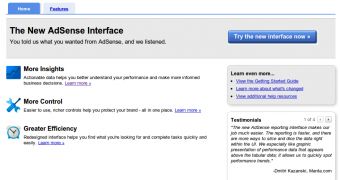The new Google AdSense interface, which has been in testing for over a year and was rolled out to a lot more people last week, is now available to all 2 million AdSense publishers. The new interface is a big improvement, Google says, and focuses on several key areas, giving users more insights, more control and more efficiency.
"Today we’re excited to be rolling out a completely new AdSense interface to all of our AdSense publishers, globally, in more than 30 languages and in each of the 200+ countries where AdSense is available," Jonathan Bellack, Director of Product Management at Google, announced.
"The AdSense interface is how publishers set up, manage, optimize and see reports on the ads on their sites," he explained.
"With this new interface, AdSense is even easier to use, and we’re also providing publishers with all the tools they need to manage and increase their advertising revenue. We used lots of direct feedback from our publishers to make this overhaul," he added.
The new interface should provide more insights on how the ads on their sites are performing.
They can see what type of ad works and what doesn't, and they can get a lot more detailed reports, broken down by things like ad units, ad size, targeting type and bid type, and track earnings and other metrics.
The new AdSense interface also allows publishers to better visualize the data and see the trends with the new graph view.
Google says that publishers will have more control over the ads and advertisers they want to work with.
Finally, the overall user experience should be better as a lot of focus was put on streamlining the interface and making everything faster.
The new interface has been in testing for over a year and has been evolving since then. In the initial test, Google rolled out the new interface to about 50,000 publishers, 30,000 of which used it on a regular basis.
Last week, the new AdSense interface was rolled out to an additional 350,000 users. Now, all 2 million publishers have access to it. However, Google is still enabling them to use the old, familiar one, to smooth out the migration process.

 14 DAY TRIAL //
14 DAY TRIAL //